First look on Panasonic HDC-TM300e
Should MiniDV cameras be changed to HDD cameras? Does SD video change to HD video? Does Sony change to Panasonic? Test HD camera Panasonic HDC-TM300
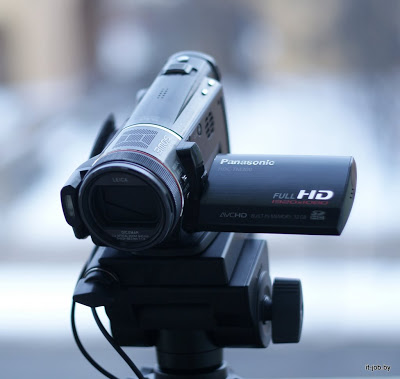
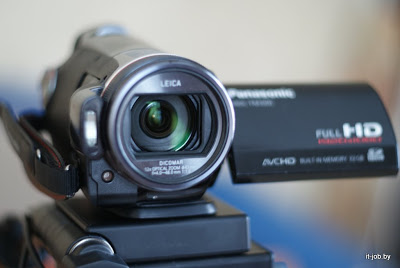
The answers to these questions are at the end of the article. The Panasonic office kindly provided us with the Panasonic HDC-TM300ee HD-video camera test - the flagship of its 2009 amateur line-up.
Since we relatively often shoot educational seminars (more than 40 hours of finished video, which means that there are more shots) - then we are relatively rare “writers” who know what to demand from the camera.
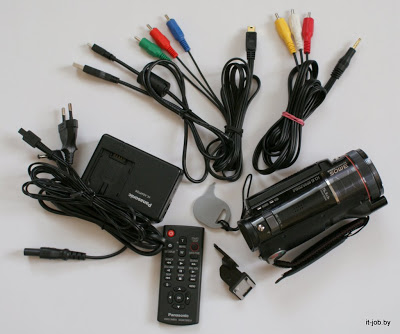
The camera attracted us, first of all, with its matrix. 3CMOS 1 / 4.1. And the built-in hard drive. Prior to that, our entire experience with video cameras was from the miniDV era. And we shot first on the Panasonic GS27 (1/6 matrix), then the Sony HC42 (1/5 matrix), then the Sony HC90 (1/3 matrix with the primary colors filter), then the Panasonic MX400 (3CCD matrix 1/6). The last camera is semi-professional.
So there is something to compare.
Convenience of use and additional equipment.
This Panasonic is an amateur camera, so everything is subject to the interests of amateurs. Touchscreen, which in any case will need to use (and, therefore, camera shake when shooting and recording touch-shake), frivolous 5.1 microphone.
Panasonic decided that the camera is self-sufficient - therefore, to connect external accessories, you need to carry a special adapter with you.

Which is a curved piece of iron with a contactless platform (cold shue). If Sony uses a sophisticated multi-pin connector to connect accessories, which allows, for example, to connect wireless microphones or light and control them through the camera (i.e., the camera exchanges information with additional equipment), in a Panasonic camera it is just a piece of iron / plastic. You can also install additional light on a tripod nearby. It is inconvenient to hold the TM300 with the installed equipment, let's say.
Sound
But Panasonic, and TM300 is no exception, there is an important plus - standards. First of all, a standard microphone jack, a standard miniusb for video draining (moreover, the camera disk is seen exactly as a disk - without additional drivers or software). If you can still tolerate “native” irreplaceable cables on the cameras, then there are no standard microphones. SONY, conventionally speaking, has about 7 “native” microphones under the “intellectual platform”. Each cost from 100 dollars, and for a hundred you get not very high quality. And you can not connect a "standard" microphone.
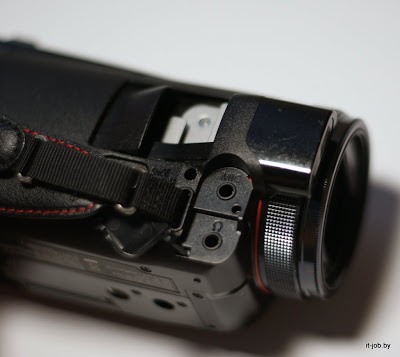
And you can connect any standard system to Panasoni. Let's say for 60-70 dollars you can buy a fairly strong “gun” with your own power, and Panasonic will gladly record it in stereo or mono along with the video. The second important plus is the ability to pick up sound from external sources. A typical scenario for educational events is when there is a microphone for sounding the hall (usually a radio or a wired system), the signal from which goes to the console. The maximum available sound quality in such conditions is to pick up the signal directly from the console. With Panasonic this is possible, with Sony - no.
The “approach” function does not impress, in fact, the microphones do not refocus, but simply turn on the signal gain. Those. if, when the sound is “approaching,” someone next to the camera (say, to the left of the camera) begins to discuss the lecturer, the further the lecturer is (the stronger zoom you use for recording), the more clearly you will hear commentators. So this function is a marketing garbage that has no practical use.
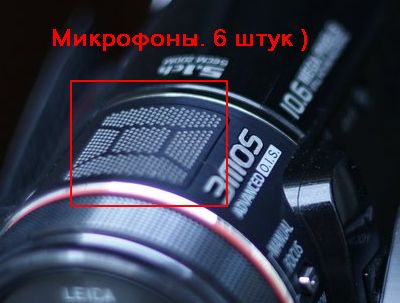
Honestly, the same situation with 5.1. It is almost impossible to edit amateur on a computer - very hard software, dances with a tambourine and knowledge requires working with six audio tracks. And even fewer situations where you can view amateur video with 5.1 sound. Therefore, write in stereo with external microphones (by the way, externally, you can only connect a stereo microphone. 6 channels for 5.1 recording cannot be connected).
But. One important "but." The quality of the recorded sound through the built-in microphones is much better than the recorded microphones in Sony. True, you should select the appropriate sound recording mode. What is done only after transferring the camera to manual mode :)
Video
Honestly, the camera was pleasantly surprised. The matrix showed more than decent results in poor light. The results are much more impressive than Sony’s 1/3 matrix for much lower resolution. Another important plus: the camera very quickly adapts to new lighting conditions and almost instantly “suffices” sharpness. However, there is a problem - manual white balance (and this is a prerequisite for high-quality video) can only be set in manual mode. And in this mode, you can not set the “tracking autofocus” - because This type of amateur function. If the speaker leaves the center of the frame, and behind it is a solid background - the camera tries to find the sharpness. Naturally, unsuccessfully.
Tracking autofocus allows you to solve this problem. Moreover, it works even after the object is out of the frame. When the lecturer returns to the frame, the camera re-finds the object selected by the operator for focusing. But then the white balance is automatic)
From read
I read the discussion that for a real high-quality fullHD, the matrix size in 1/4 is too small. Fundamentally agree, the idea is correct. If 1/3 of the amateur camera for 768px in width had issues with noise, then 1/4 for resolution in 1900px in width - 1 pixel accounts for much less than the physical size of the matrix. However, I’m sure that the “warm tube sound” and “cold tube sound” (meaning the quality of the captured video) can only be distinguished on very large and expensive plasma TVs with a magnifying glass when analyzing freeze frames. In general, in the amateur video is much more important "what", and not "how" removed.
What we don't
- We did not test the quality of the codec compression on flowing water
- We did not test the CMOS matrix when shooting a burning candle
- We didn’t test the 10 megapixel photo mode (because it’s ridiculous on the 1/4 matrix, as well as making the camcorder to be a camera)
Summary
The cost of the camera is about $ 1200. She is an amateur. Regular battery lasts more than half an hour. The camera is sturdy, but compact. There is a Russian language in the menu. We were a little surprised at the separation of functions into “amateur” and “manual”. And the fact that they can not be combined. In particular, he was upset that “tracking objects” was in the amateur part, and white balance and microphone switching to stereo mode were in manual settings.
The capabilities of this camera are more than enough for us. The matrix makes less noise than all that we managed to try (but it was all MiniDV cameras), the sound with the built-in microphones is recorded better and cleaner.
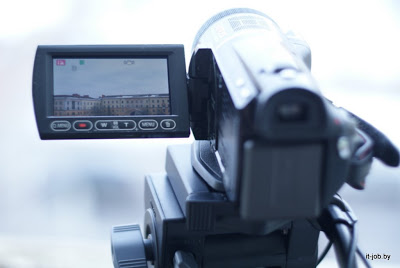
The computer sees the disk with the .mts files located there, which are well understood by default, say MediaPlayer Classic and the usual modern amateur editing and encoding programs. (but even for HD viewing you need a good comp, a laptop with Core2Duo, hmm-hmm, slows down)
If the unlim-channel becomes cheaper in Belarus, then it is quite possible to allow to upload the HD version of the footage on youtube or vimeo. If the Internet is cheaper, it is very likely that the HD versions will be watched).
Pleased that it is easy to get and process the footage. However, HD processing requires an ooooooooooooooooochen powerful computer.
The camera, in addition to the 160Gb hard drive, allows you to feed yourself with SD cards (the most expensive of which already have 32Gb, while remaining all the same small). And it is possible to rewrite the data between the hard drive and the card without a computer!
In unambiguous advantages - support for standard input / output. Separately microphone input, separate headphone output, A / V and composite outputs, HDMI (for direct connection to cool HD TVs), standard mini USB.
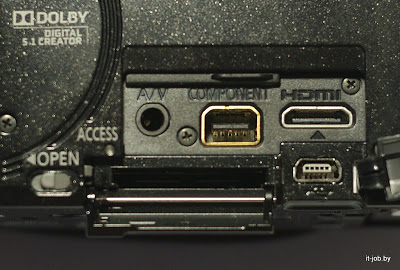
What can stop from buying is the price. Such a camera will be bought by young families for shooting children only after a car, a plasma TV and a very very very powerful computer. We can not say that for HD, a triple matrix and a touchscreen, the price is not fair. The devices for obtaining this quality, alas, cost so much.
But it is obvious that the era of miniDV cameras has passed, cameras with hard drives are much more convenient and practical, a camera with standard inputs is much more attractive. Therefore, the answers to the questions posed in the title: Yes, yes, yes. Everything speaks for Panasonic.
')
Source: https://habr.com/ru/post/86499/
All Articles